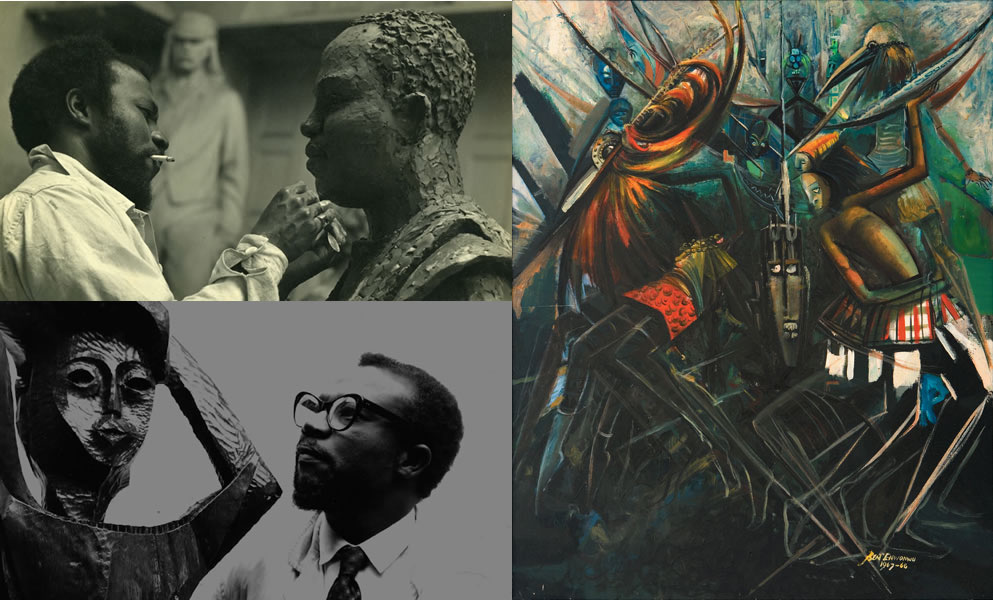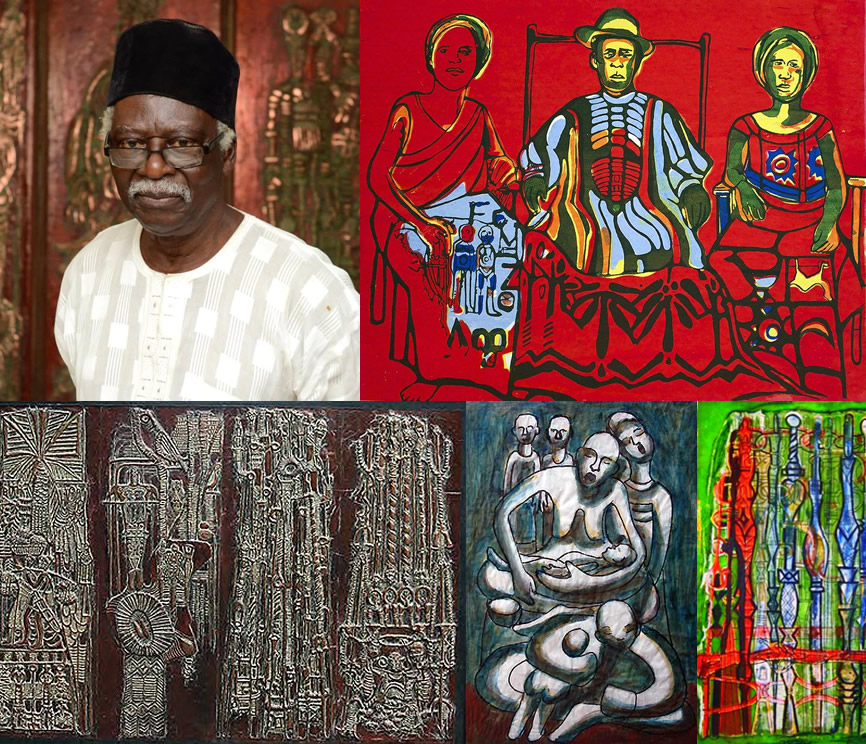Home > Artist on Focus

Enwonwu, Benedict (Ben) Chukwukadibia (1921 – 1994) Artist, Painter, Sculptor was born a twin on July 14th, 1921 in Onitsha, Anambra State, Nigeria in to the noble family of Umueze-Aroli in Onitsha. His father was Omenka Odigwe Emeka Enwonu a technician and a sculptor who worked for the Royal Nigeria Company and his mother Ilom was a successful cloth trader.
He had his secondary education at St. Patrick’s School Ibusa and Government College Ibadan in 1934, where he met Kenneth Murray. He left with Kenneth Murray for Government Umuahia. Ben Enwonwu was said to be the most gifted and technically proficient (Enwonwu foundation), he held an exhibition of his own works in 1938 at Glasgow Empire exhibition. In 1939 he was awarded a prize and bronze medal by International Business Machines (IBM). He had an exhibition of his painting and wood carvings December 31st – January 15th 1944 in London during which he met Mr. L. N. Hartford a director of Shell West Africa who helped secure a joint scholarship with Shell and the British Council that made it possible for Enwonwu to return to Britain to study art in England. He started at Ruskin School of Art in Oxford and went on to the prestigious Slade School of Fine Art University London, 1944 – 1947, he also attended Goldsmith College. He graduated from Slade with a first Class honors diploma in Sculpture. After graduation from Slade he enrolled at the University of London post graduate studies in Anthropology. In 1948 he graduated from the University of London and became a fellow of the Royal Anthropological Institute of Great Britain and Ireland and was elected to the Royal Society of British Artists.
In 1948 Ben Enwonwu returned to Nigeria and worked as an Artist Adviser to the Federal Government, he was said to have painted one of his famous works, Monotony that was acquired for the Bishop Olter Art Collection; he has become known internationally, he is described as the most renowned Nigerian Artist of the 20th Century. In 1956 he became even more famous when he was commissioned by the British Government to do a portrait of Queen Elizabeth II. A copy of the bronze sculpture stands at the parliament Building in Lagos, while the original resides in the Queens Art Collection.
Emily Robson a known art critic said that his style can be considered African modernist. His work she states offers a blend of various styles and elements of traditional West African masks into simplified body emphasis on the face, but also toned – down expression from Europe, he was able to move between cultures as he was trained professionally by the British and had his innate African skills as a sculptor.
He continued to be very productive in wood, paint and bronze, had numerous exhibitions, December 1949, African Dancers and Agbogho – Mmuo, the Onitsha masquerades Exhibition at the Lagos Center, 1950 Berkely Galleries, London, July 13th – 14th August Gallery Apollinaire, Milan, became a member of preserve African Cultural Organization. In 1954 he became a member of the most distinguished order of the British Empire (OBE). He was commissioned by the Federal Government to produce a sculpture that would symbolize the new Nigerian nation for the National Museum, the resulting was the sculpture ‘Anyanwu’ (Sunshine in Igbo) remains one of his most visible works.
He held several positions in the world of Art both in Nigeria and abroad, 1966 – 1968 he became a fellow of the University of Lagos, he was appointed Art supervisor to the federal government a position he held till 1971. In 1975 he was awarded one of the highest national honors , Officer of the National Order of the Republic. In 1977 he was appointed Art Consultant to the International Secretariat, second world Black and African Festival of Art and Culture. He continued to produce public sculpture for Nigerian entities.
He was commissioned to create works for public buildings, The Drummer Boy was produced for the Nigeria Telecommunications Headquarters in Lagos, He was commissioned in 1964 to produce a sculpture for the Nigerian Electric Board’s new building in Marina, and the resulting sculpture is Sango, Yoruba god of thunder which remains one of his most famous public sculptures. He also continued to hold exhibitions, in 1985 a major retrospective exhibition was organized by Royal Society of Arts at the Mall Galleries, London, October 4th – 11th, he moved the same exhibition to Lagos at the home of the British Higher Commission in Lagos in 1987, he held his last major exhibition at the National Museum in Lagos in 1990.
Ben Enwonwu was married twice and had nine children, four sons and five daughters. He died quietly in his sleep on February 4th, 1994 at his home in Lagos. Ben Enwonwu will be remembered as one of the most prominent African Artist whose work inspire younger Artist and who help create an international visibility of African Art in all media, wood bronze and painting.
By Dr. Elsie Okobi (2010) Unpublished
Ben Enwonwu

Enwonwu, Benedict (Ben) Chukwukadibia (1921 – 1994) Artist, Painter, Sculptor was born a twin on July 14th, 1921 in Onitsha, Anambra State, Nigeria in to the noble family of Umueze-Aroli in Onitsha. His father was Omenka Odigwe Emeka Enwonu a technician and a sculptor who worked for the Royal Nigeria Company and his mother Ilom was a successful cloth trader.
He had his secondary education at St. Patrick’s School Ibusa and Government College Ibadan in 1934, where he met Kenneth Murray. He left with Kenneth Murray for Government Umuahia. Ben Enwonwu was said to be the most gifted and technically proficient (Enwonwu foundation), he held an exhibition of his own works in 1938 at Glasgow Empire exhibition. In 1939 he was awarded a prize and bronze medal by International Business Machines (IBM). He had an exhibition of his painting and wood carvings December 31st – January 15th 1944 in London during which he met Mr. L. N. Hartford a director of Shell West Africa who helped secure a joint scholarship with Shell and the British Council that made it possible for Enwonwu to return to Britain to study art in England. He started at Ruskin School of Art in Oxford and went on to the prestigious Slade School of Fine Art University London, 1944 – 1947, he also attended Goldsmith College. He graduated from Slade with a first Class honors diploma in Sculpture. After graduation from Slade he enrolled at the University of London post graduate studies in Anthropology. In 1948 he graduated from the University of London and became a fellow of the Royal Anthropological Institute of Great Britain and Ireland and was elected to the Royal Society of British Artists.
In 1948 Ben Enwonwu returned to Nigeria and worked as an Artist Adviser to the Federal Government, he was said to have painted one of his famous works, Monotony that was acquired for the Bishop Olter Art Collection; he has become known internationally, he is described as the most renowned Nigerian Artist of the 20th Century. In 1956 he became even more famous when he was commissioned by the British Government to do a portrait of Queen Elizabeth II. A copy of the bronze sculpture stands at the parliament Building in Lagos, while the original resides in the Queens Art Collection.
Emily Robson a known art critic said that his style can be considered African modernist. His work she states offers a blend of various styles and elements of traditional West African masks into simplified body emphasis on the face, but also toned – down expression from Europe, he was able to move between cultures as he was trained professionally by the British and had his innate African skills as a sculptor.
He continued to be very productive in wood, paint and bronze, had numerous exhibitions, December 1949, African Dancers and Agbogho – Mmuo, the Onitsha masquerades Exhibition at the Lagos Center, 1950 Berkely Galleries, London, July 13th – 14th August Gallery Apollinaire, Milan, became a member of preserve African Cultural Organization. In 1954 he became a member of the most distinguished order of the British Empire (OBE). He was commissioned by the Federal Government to produce a sculpture that would symbolize the new Nigerian nation for the National Museum, the resulting was the sculpture ‘Anyanwu’ (Sunshine in Igbo) remains one of his most visible works.
He held several positions in the world of Art both in Nigeria and abroad, 1966 – 1968 he became a fellow of the University of Lagos, he was appointed Art supervisor to the federal government a position he held till 1971. In 1975 he was awarded one of the highest national honors , Officer of the National Order of the Republic. In 1977 he was appointed Art Consultant to the International Secretariat, second world Black and African Festival of Art and Culture. He continued to produce public sculpture for Nigerian entities.
He was commissioned to create works for public buildings, The Drummer Boy was produced for the Nigeria Telecommunications Headquarters in Lagos, He was commissioned in 1964 to produce a sculpture for the Nigerian Electric Board’s new building in Marina, and the resulting sculpture is Sango, Yoruba god of thunder which remains one of his most famous public sculptures. He also continued to hold exhibitions, in 1985 a major retrospective exhibition was organized by Royal Society of Arts at the Mall Galleries, London, October 4th – 11th, he moved the same exhibition to Lagos at the home of the British Higher Commission in Lagos in 1987, he held his last major exhibition at the National Museum in Lagos in 1990.
Ben Enwonwu was married twice and had nine children, four sons and five daughters. He died quietly in his sleep on February 4th, 1994 at his home in Lagos. Ben Enwonwu will be remembered as one of the most prominent African Artist whose work inspire younger Artist and who help create an international visibility of African Art in all media, wood bronze and painting.
By Dr. Elsie Okobi (2010) Unpublished
Artist on Focus
Dele Jegede

Dr. dele jegede, Professor Emeritus of Miami University, Oxford, Ohio, has over four decades of experience as artist, art historian, painter, cartoonist, art critic, curator, and art administrator.
[Continue reading]
Uche Okeke

Christopher Uchefuna Okeke was born on 30 April 1933 in Nimo, Njikoka Local Government Area of Anambra State, Nigeria, to Isaac Okonkwo Okeke and Monica Mgboye Okeke (née Okoye). Between 1940 and 1...
[Continue reading]
Bruce Onobrakpeya

Bruce Onobrakpeya born in Agbarha-Otor, Delta State, Nigeria in 1932, is one of African’s best known and most highly respected artists. A printmaker, painter and sculptor, he has been described...
[Continue reading]
Ben Enwonwu

Enwonwu, Benedict (Ben) Chukwukadibia (1921 – 1994) Artist, Painter, Sculptor was born a twin on July 14th, 1921 in Onitsha, Anambra State, Nigeria in to the noble family of Umueze-Aroli in Oni...
[Continue reading]
Nike Davies-Okundaye

Chief (Mrs) Nike Davies-Okundaye was born in 1951 in Ogidi-Ijumu, Kogi State, Nigeria. She was brought up amidst the traditional weaving and dying practice in her native village of Ogidi in Western Ni...
[Continue reading]
Yusuf Grillo
Yusuf Grillo (born 1934) is a contemporary Nigerian artist known for his inventive works and the prominence of the color blue in many of his paintings. He was president of the Society of Nigerian Arti...
[Continue reading]
[First Page] [Prev] Page 8 of 8